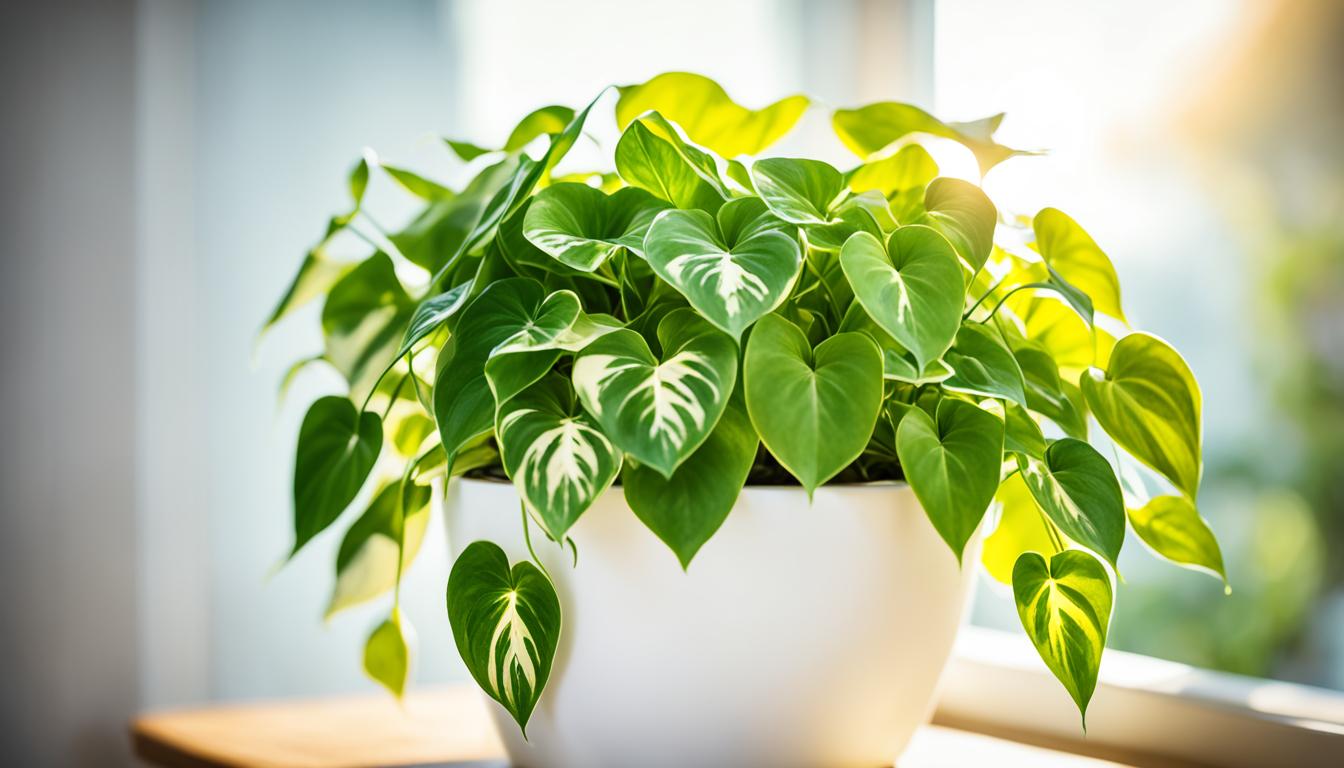Did you know the Golden Pothos is a top indoor plant? It’s known as Devil’s Ivy too. Many love it for its beautiful leaves and easy care. But, there’s lots more to learn about this plant. This guide will show you how to grow and care for Golden Pothos. We’ll talk about how it cleans the air, its size, and how to keep it happy. Let’s dive into the world of this amazing plant!
Key Takeaways:
- Golden Pothos, also known as Devil’s Ivy, is a highly popular indoor plant.
- It is appreciated for its lush foliage and easy care.
- The Golden Pothos is an excellent air-purifying plant, making it a great addition to any living space.
- It can grow quite large, with trailing vines that can reach up to 10 feet in length.
- Proper potting, light, watering, and fertilization are key to its health and vitality.
Why Do We Love the Golden Pothos/Devil’s Ivy For Apartments?
The Golden Pothos, also known as Devil’s Ivy, is perfect for apartment living. It’s easy to care for and grows well indoors.
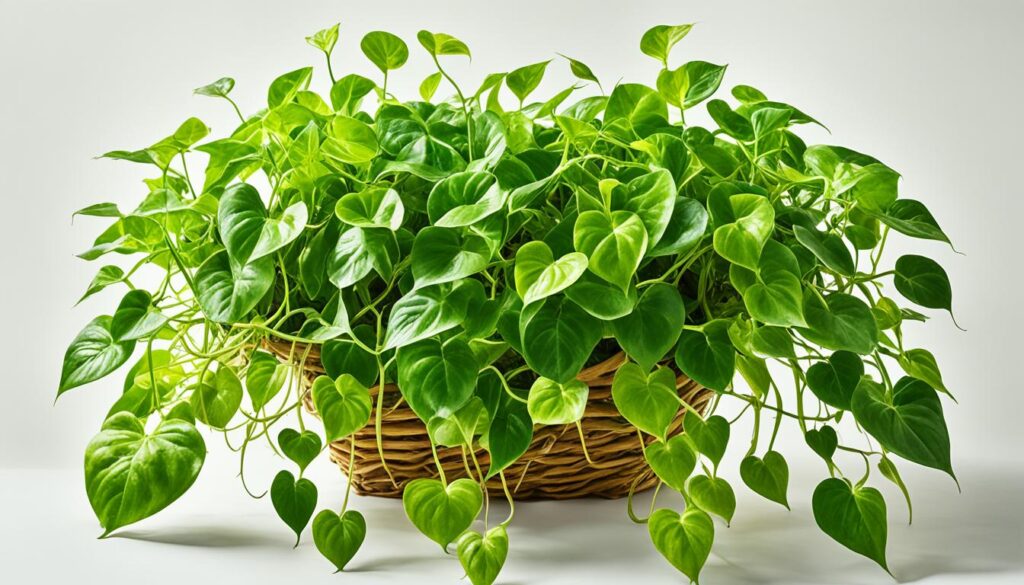
Air-Purifying Qualities
The Golden Pothos cleans the air. It removes harmful toxins like formaldehyde and benzene.
Its big leaves and long vines work like a natural air filter. This makes the air in your home healthier.
Pet-Friendly Plant
The Golden Pothos is safe for pets. It’s non-toxic to cats and dogs.
But, it’s best to keep it away from curious pets. You can enjoy this plant without worrying about pet safety.
Impressive Size and Growth
The Golden Pothos grows big and is very eye-catching. Its vines can get up to 10 feet long.
It can fill up empty spaces and make your apartment green. With some care, it makes your home look like a lush oasis.
The Golden Pothos is great for better air, a pet-safe home, and adding nature inside. Its easy care, air cleaning, and big growth make it a favorite.
How to Grow a Golden Pothos/Devil’s Ivy – Learn to Grow this Indoor Beauty
Growing Golden Pothos, or Devil’s Ivy, is fun. You just need to know a few things. I’ll show you how to keep your plant healthy and looking great.
Choosing the Right Pot and Soil
Choose a pot with holes at the bottom. This stops water from getting stuck. Use peat moss, perlite, and soil. They keep the plant happy.
Providing Adequate Light
Golden Pothos likes a lot of light, but not directly. Keep it near a window that gets some sun. Too much sun is bad for the plant.
Watering and Humidity
Don’t water your plant too much. Let the soil get a bit dry first. It’s important to find the right balance. A bit of mist keeps it happy.
Nutrition and Fertilization
Feed your plant every 2-4 weeks in its growing season. Use a balanced fertilizer. Be sure to follow the instructions.
Pruning and Maintenance
Cut off the long vines and yellow leaves. It keeps the plant healthy. Remove dead stuff to stop bugs and diseases.
Propagation
You can make new plants with stem cuttings or division. Cut a vine below a leaf and put it in water or soil. Or, split the plant if it’s big.
Monitoring for Pests and Diseases
Look out for pests like mealybugs or spider mites. If you see bugs, deal with them fast. This keeps your plant safe.

Growing Golden Pothos inside makes your home pretty. Follow these steps for potting, light, and care. You’ll have a beautiful, healthy plant. Enjoy taking care of your indoor plant!
Appearance of Golden Pothos/Devil’s Ivy
The Golden Pothos, or Devil’s Ivy, is a beautiful plant. It looks great indoors. It has vines that trail and leaves shaped like hearts. This makes it look graceful and lovely. In addition to its stunning appearance, the Golden Pothos is known for being low-maintenance, making it a perfect choice for both novice and experienced plant enthusiasts. To ensure its health, it’s important to follow specific care guidelines, just as with other houseplants. For those interested in optimizing their indoor gardening experience, incorporating peace lily care tips can further enhance air quality and create a vibrant living space.
The leaves are a bright green with gold or yellow spots. These colors make the plant look really special. You can hang it up or put it on a table. Either way, it makes any room look better.
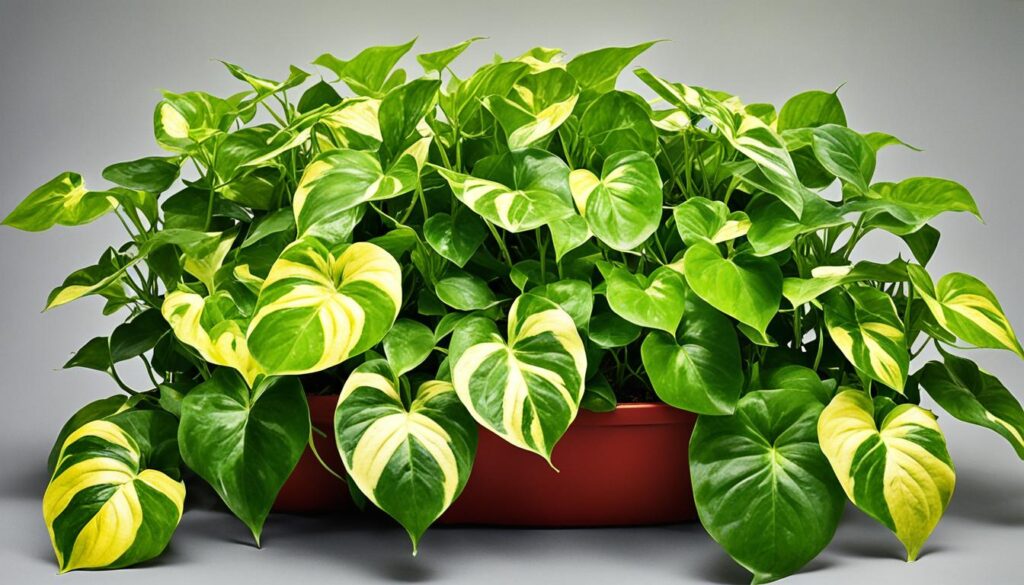
Light Requirements for Golden Pothos/Devil’s Ivy
The Golden Pothos needs a good amount of light to grow well. It loves bright but not direct sunlight. This makes it a great plant for rooms with lots of light or near windows that don’t let in harsh sun. Too much direct sunlight can harm its leaves. However, it can also grow in less light, but slower and with less colorful leaves.
Finding the perfect light for your Golden Pothos is key. Look out for leaves that turn pale or yellow. This means it needs more light. But, if leaves get brown spots or look too dark, it’s getting too much direct sun.
Here are ways to keep your Golden Pothos happy with the right light:
- Put the plant where it can get plenty of light without direct sun.
- Keep it away from too much direct sunlight, especially in the hot afternoons.
- If there’s not enough sunlight, use grow lights to help it out.
- Turn the plant now and then so all sides get light and grow evenly.
By knowing what light your Golden Pothos needs, you can help it grow strong and look beautiful all year.

Watering Requirements of the Golden Pothos/Devil’s Ivy
The Golden Pothos, or Devil’s Ivy, needs careful watering. Knowing when and how much to water is key.
Signs of Overwatering vs. Underwatering
Watering Golden Pothos right is important. Too much water can harm it, and not enough water can also cause problems. Look for signs to keep your plant healthy.
Signs of overwatering:
- Yellowing leaves
- Soggy soil
- Foul odor
- Mold or fungus growth
Signs of underwatering:
- Wilting leaves
- Dry soil
- Leaf drop
- Brittle stems
To avoid too much water, let the soil dry a bit first. If the soil is dry an inch down, it’s time to water. This plant likes it a bit dry.
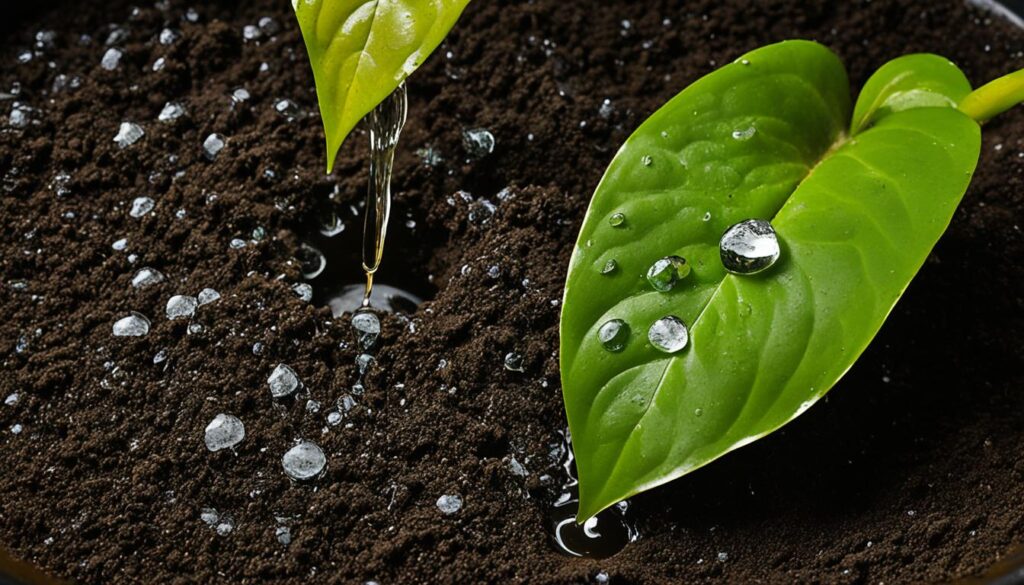
Wet the soil well until it drains at the bottom. This keeps roots healthy by not letting water sit. Don’t let the plant sit in water, to avoid root issues.
How often to water depends on things like temperature and pot size. Always check the soil and change how you water as needed.
With the right watering, your Golden Pothos will grow well. It’ll make your space more pleasant.
Fertilizing a Golden Pothos/Devil’s Ivy
Help your Golden Pothos or Devil’s Ivy grow with some fertilizer. The right kind gives them important nutrients. Let’s look into the best fertilizers for these plants.
Recommended Fertilizer for a Golden Pothos/Devil’s Ivy
Use a balanced, water-soluble fertilizer for your plants. It should have nitrogen, phosphorus, and potassium. These are key for growth.
Water-soluble fertilizers reach the plant’s roots quickly. This helps the plant get nutrients fast. It also helps you control how much you use to avoid harm.
Always follow the fertilizer package’s instructions. Different brands need different amounts. Too much fertilizer can hurt your plants.
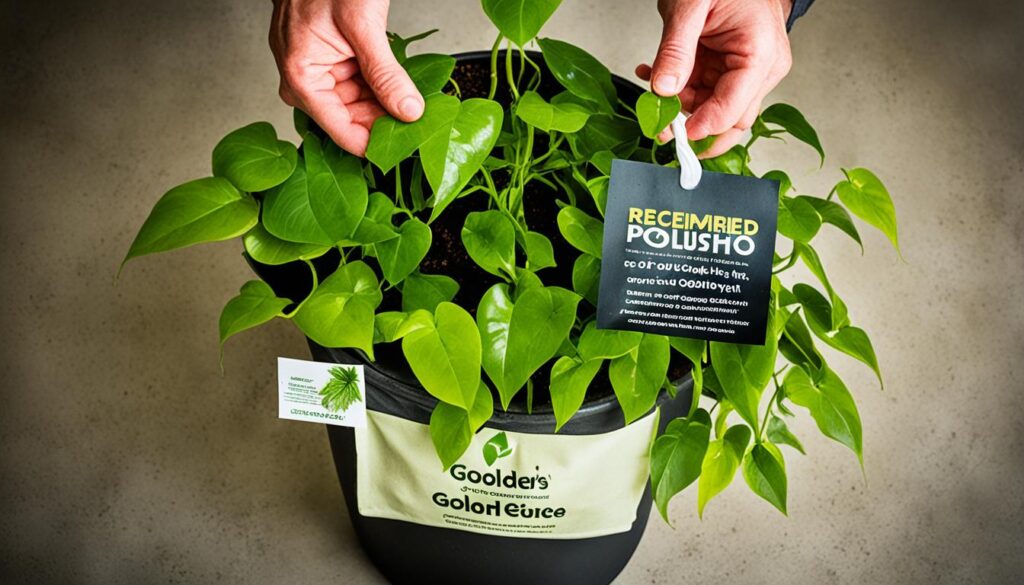
Using the correct fertilizer and instructions helps your plants. They will be healthy and have bright leaves.
Potting a Golden Pothos/Devil’s Ivy
When you pot a Golden Pothos or Devil’s Ivy, remember a few things. Choose the right pot, use the best soil, and know when to repot. These help your plant grow well.
Choosing the Right Pot Size
Choosing a pot for your plant is key. It should let roots grow but not be too big. If the pot’s too big, the soil may stay wet. This can harm the roots. A pot that’s 2-4 inches wider than the plant’s roots is best.
Using the Right Potting Mix for a Golden Pothos/Devil’s Ivy
The soil mix is very important for your plant’s health. Use soil that drains well but keeps some moisture. Mix peat moss, perlite, and vermiculite. Or, use a special indoor plant mix. This helps roots grow strong.
Repotting When Necessary
Plants grow and might need more space. Or, the soil gets hard. This means it’s time to repot. Signs include roots out the bottom, slow growth, or soil that dries fast. Try to repot every 1-2 years or when needed.
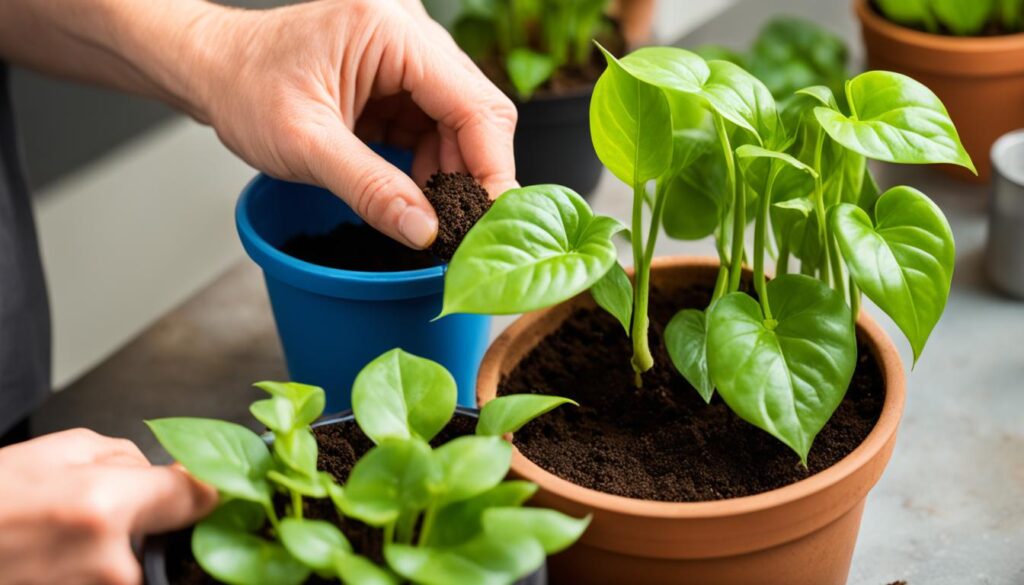
Propagating a Golden Pothos/Devil’s Ivy
The Golden Pothos is also called Devil’s Ivy. It’s easy to make more of these plants.
You can use stem cuttings or division to do this.
Stem Cuttings Or Seeds?
Stem cuttings are the best way to make new Golden Pothos plants. You take a healthy piece of a plant. Then, you put it in water or dirt until it grows roots.
This way, the new plants will be just like their parent. Growing from seeds is harder and takes longer. So, most people prefer stem cuttings.
Division Of A Golden Pothos/Devil’s Ivy
You can also make new plants by dividing a Golden Pothos. Do this when your plant has many stems or shoots. Gently split the plant into pieces that have roots and stems. Then, plant them again to make new plants.
If your Golden Pothos is too big, division is a good idea. It’s an easy way to get more plants. It doesn’t hurt the parent plant much.
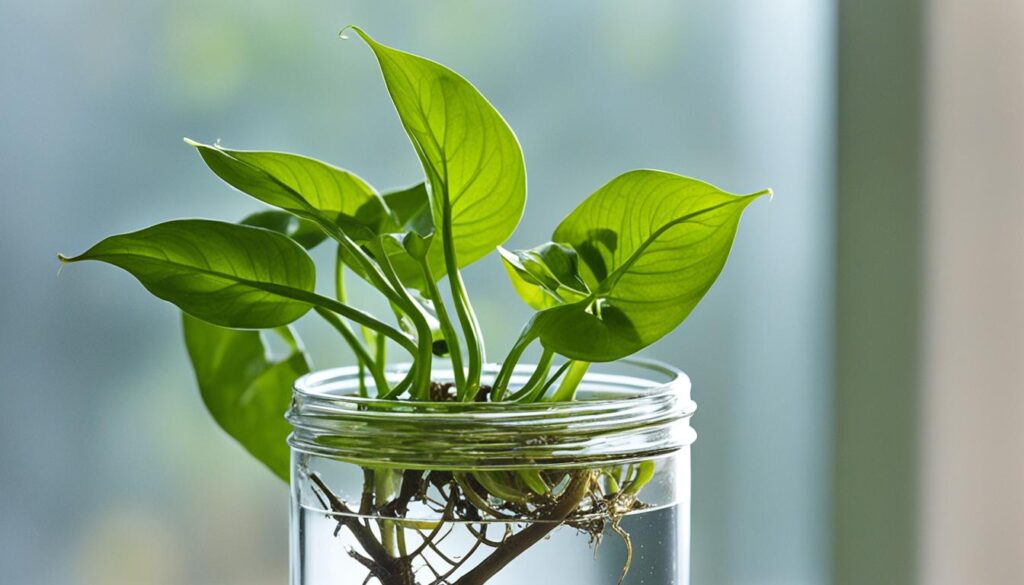
| Propagating Method | Advantages | Disadvantages |
|---|---|---|
| Stem Cuttings | Simple and reliable method | Takes time for roots to develop |
| Division | Allows for expansion of plant collection | Parent plant may experience temporary setback during division |
Growth and Development of the Golden Pothos/Devil’s Ivy
The Golden Pothos, or Devil’s Ivy, grows well inside, especially when it’s warm. It’s important to know how it grows to keep it healthy.
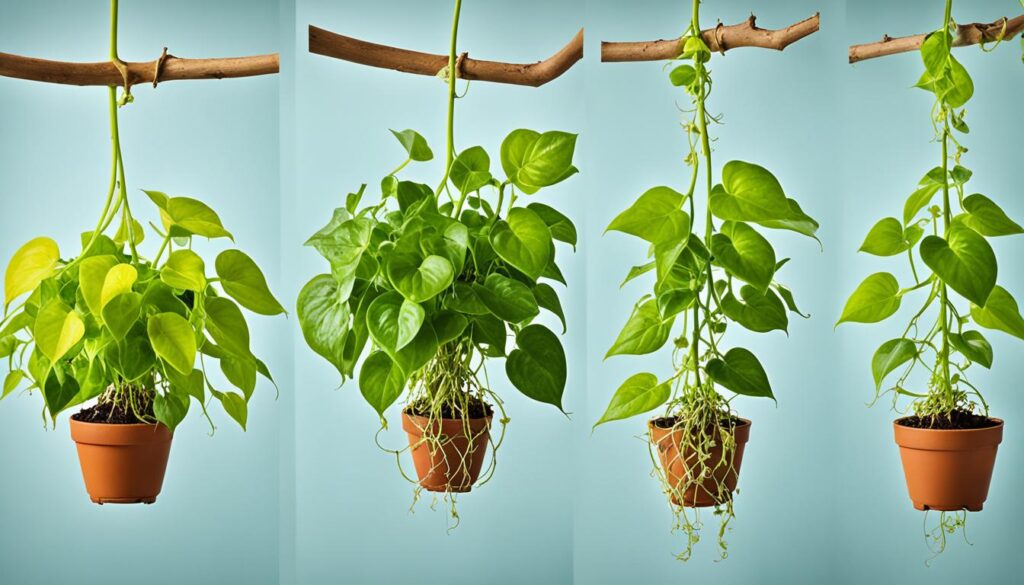
This plant can get really long indoors, reaching 6-10 feet. In the wild, it can grow even up to 60 feet. With good care, it makes your space greener and prettier.
For the best growth, give your Golden Pothos what it needs. This means enough light, water, and the right humidity. Don’t forget to trim it and feed it too.
If you get to know how the Golden Pothos grows, you can help it do well. It will be a beautiful part of your indoor garden.
Dealing with Pests and Diseases in the Golden Pothos/Devil’s Ivy
The Golden Pothos is usually strong against pests and diseases. Yet, it can sometimes have problems. Pests like mealybugs, spider mites, and scale might attack. They harm the leaves, slow growth, and make the plant weak.
It’s vital to check your plant often. This helps find pests early. Look for tiny webs, white cottony stuff, or little bugs. If you see these, act fast to stop more damage.
For pests, you have two choices: natural ways or chemicals. Natural ways mean using things like neem oil or insecticidal soaps. You can also use ladybugs.
If pests don’t go away with natural methods, you might need chemicals. Pick a safe pesticide for indoor plants. And follow the directions to keep your plant safe.
Stopping diseases is key to a healthy Golden Pothos. Here’s how to prevent diseases:
- Keep your plant where air can move around it freely.
- Don’t overwater to avoid root rot and fungal diseases.
- Clean the leaves often to keep them dust-free.
- Keep sick plants away from your healthy ones.
- Watch your plant for any signs of sickness.
Prevent pests and diseases with these steps. Your Golden Pothos will stay strong and beautiful.
Common Golden Pothos/Devil’s Ivy Pests
The Golden Pothos, also known as Devil’s Ivy, gets attacked by pests. These pests harm its leaves and health. Know these pests and how to stop them. Some common pests are:
- Mealybugs: Small, white bugs that look like cotton. They gather on leaves and stems. They drink the plant’s sap. This turns leaves yellow, makes the plant wilt, and stops growth.
- Spider Mites: Tiny, spider-like bugs. They spin webs on leaves and stems. They eat the plant sap. This makes leaves turn yellow, spotted, and webbed.
- Scale: Small, oval bumps on leaves and stems. They suck the plant’s sap. This makes the plant turn yellow, wilt, and get sick.
Regular checks are key for spotting these pests early. Look at your plant’s leaves, stems, and underparts for bugs or harm.
Seeing pest signs means you must act fast to stop more harm. Here are ways to fight these pests:
- Natural Predators: Have good bugs like ladybugs around. They eat the bad pests.
- Isolate Infected Plants: Keep sick plants away from healthy ones. This stops pests from spreading.
- Chemical Treatment: Use special bug killers if the problem is big. Use them as told and pick ones made for your plant’s pests.
Check your Golden Pothos often. Stop pests before they start. Act fast if pests show up. This keeps your plant healthy and growing well.
Natural Predators
Isolate Infected Plants
Got pests on your Golden Pothos or Devil’s Ivy? First, keep sick plants away from healthy ones. This limits pests from moving to other plants.
Chemical Treatment
Sometimes, bugs don’t leave with just good bugs eating them. You might need chemicals. Use them only if nothing else works. Pick the right one for the bug and read directions.
Chemicals can manage pests. But be careful and follow the label. Think about nature too. Mix in some good bugs with your plant care plan. Always think about your plant’s health first.
| Pest Control Method | Pros | Cons |
|---|---|---|
| Natural Predators | – Can help control pest populations – Environmentally friendly – Can be a long-term solution | – May take time for predators to show results – Predators may not completely eliminate the pests |
| Isolate Infected Plants | – Prevents spread of pests to other plants – Allows for targeted treatment of the infected plant | – Requires space and separate containers – May not be suitable for large infestations |
| Chemical Treatment | – Can quickly eliminate pests – Effective for severe infestations | – Potential harm to beneficial insects – Environmental impact if not used responsibly – Follow safety precautions |
Disease Prevention For Golden Pothos/Devil’s Ivys
Keeping your Golden Pothos healthy is important. A few key steps can help it stay free of disease.
First, don’t overwater your plant. It likes to stay a bit dry. Make sure the soil dries out before you water it again. Too much water can cause root rot and other bad stuff.
Good air around your plant is key too. Put it where air can move freely. This stops too many plants from making the air stuffy.
Keeping the plant clean is very important. Wipe its leaves with a wet cloth or sponge. This takes away dust and bad tiny bugs.
Always watch your plant closely. Look for signs like leaves changing color or spots. If you see anything strange, fix it fast to stop more problems.
If you do all these things, your Golden Pothos will grow well and stay happy.
Tips for Maintaining Golden Pothos/Devil’s Ivys
Keep your Golden Pothos, or Devil’s Ivy, healthy with good care. Follow these tips for a thriving and beautiful plant.
Wiping Leaves
It’s important to wipe your plant’s leaves regularly. Dust and dirt block sun, making leaves dull.
Wipe with a soft, damp cloth. This makes leaves shiny and stops pests.
Outdoor Exposure
Sometimes, put your plant outside but in the shade. A few hours outside makes it grow well.
But, keep it out of strong sunlight. Move it outside slowly to prevent shock.
Adjusting Watering Schedule
Change how often you water with the seasons. The plant needs more water when it’s warm.
In colder months, water less. Watch the leaves and soil to know when to water.
| Season | Watering Frequency |
|---|---|
| Spring and Summer | Water when the top inch of soil feels dry |
| Fall and Winter | Allow the soil to dry out slightly between waterings |
Use these tips to keep your Golden Pothos healthy. It will look great in your space.
Tips for Successful Overwintering of Golden Pothos/Devil’s Ivy
It’s key to protect your Golden Pothos in winter. This will help it stay healthy and grow well later.
- Provide appropriate light: Place your plant where it gets plenty of indirect sunlight. This will keep it healthy and stop it from growing too long and thin.
- Adjust watering frequency: You’ll need to water your plant less in the winter. Make sure the soil is a bit dry before you water again. This stops too much water from hurting the roots.
- Avoid drafts: Keep your plant away from cold air near windows and doors. A steady warm spot helps it do well in the cold months.
Follow these steps to keep your Golden Pothos happy and pretty in winter. Then, it will be ready to bloom beautifully in spring.
Growing Golden Pothos/Devil’s Ivy from Seed
Some people like to grow Golden Pothos/Devil’s Ivy from seeds. This way is less common and needs special conditions and patience.
To grow from seeds, make sure the seeds are fresh and good. It takes time for seeds to grow. You must be patient and take good care of them.
Here are the general steps to grow Golden Pothos/Devil’s Ivy from seed:
- Start by soaking the seeds in warm water for a few hours to soften the tough outer shell and promote germination.
- Prepare a seed tray or small pots filled with a well-draining potting mix. Moisten the soil lightly.
- Plant the seeds about 1/4 inch deep and cover them with a thin layer of soil.
- Place the tray or pots in a warm, well-lit area with temperatures around 70-80°F (21-27°C).
- Keep the soil consistently moist but not soggy. Using a spray bottle can help maintain the right moisture level without overwatering.
- It may take several weeks for the seeds to germinate. Be patient and continue to provide the ideal conditions.
- Once the seedlings have grown a few sets of leaves and are strong, they can be moved to individual pots.
- Continue caring for the seedlings like grown plants. Give them light, water, and food.
Not all seeds will grow, and the new plants might look different. But growing Golden Pothos/Devil’s Ivy from seed is rewarding for plant lovers.
Varieties of Golden Pothos/Devil’s Ivy
The Golden Pothos, also known as Devil’s Ivy, has many exciting types. Each one has its special look and traits. You can choose from the classic Golden Pothos, elegant Marble Queen, deep green Jade, or bright Neon Pothos.
Every Golden Pothos variety looks a bit different. They have cool shades in their leaves. The Golden Pothos has bright green leaves with golden spots. These spots make any room feel warm and cozy.
The Marble Queen Pothos has green and white leaves. It looks very elegant. The Jade Pothos has very green leaves. It makes a room feel calm and peaceful. The Neon Pothos has bright green leaves. It makes any space lively and fun.
You might like the classic Golden Pothos or the fancy Marble Queen Pothos. Or maybe the calm Jade Pothos or the bright Neon Pothos is for you. Any choice will make your space look great.
FAQ
Q: Why Do We Love the Golden Pothos/Devil’s Ivy For Apartments?
A: It’s easy to care for and does well inside. Perfect for apartment life.
Q: Is the Golden Pothos/Devil’s Ivy Air-Purifying?
A: Yes, it cleans the air. This makes it a great plant for your home.
Q: Is the Golden Pothos/Devil’s Ivy Pet Friendly?
A: It’s safe for pets if you keep it out of their reach.
Q: How Big Does the Golden Pothos/Devil’s Ivy Get?
A: It can grow really big, up to 10 feet long.
Q: How to Grow a Golden Pothos/Devil’s Ivy – Learn to Grow this Indoor Beauty
A: It’s easy to grow a Golden Pothos. But, you need to know a few things.
These include the right pot, soil, enough light, and water. Also, you need the right air humidity and food.
Don’t forget to cut it back sometimes. Watch out for bugs and sickness too.
Q: What Pot and Soil Should I Choose for the Golden Pothos/Devil’s Ivy?
A: The right pot and soil are very important. Pick a pot that’s not too big.
The soil should drain well but keep a bit of water. This helps the plant stay healthy.
Q: How Much Light Does the Golden Pothos/Devil’s Ivy Need?
A: It loves bright, indirect light. But, it can also live in less light.
Too much direct sun is bad. The right light helps it grow well.
Q: How Should I Water the Golden Pothos/Devil’s Ivy?
A: Keep it more on the dry side. Let the soil dry before watering again.
Yellow leaves mean too much water. Wilting means it needs more water.
Q: How Often Should I Fertilize the Golden Pothos/Devil’s Ivy?
A: It doesn’t need much food. But feeding it sometimes helps it grow.
Use a balanced food for houseplants. Always follow the food’s directions.
Q: How Do I Repot the Golden Pothos/Devil’s Ivy?
A: Repot when it’s too big for its pot or the soil is not good anymore.
Pick a bigger pot and use good soil. Be careful with the roots.
Q: How Can I Propagate the Golden Pothos/Devil’s Ivy?
A: You can make more plants with stem cuttings or by splitting the plant.
Both ways are easy and work well. This way, you can have more plants.
Q: What Are Common Pests and Diseases of the Golden Pothos/Devil’s Ivy?
A: Bugs like mealybugs, spider mites, and scale can bother it. Check your plant often.
If you find bugs, treat them fast. Also, keep an eye out for disease.
Q: How Can I Prevent Diseases in the Golden Pothos/Devil’s Ivy?
A: Keeping it healthy stops disease. Don’t overwater and let air around it.
Always clean and watch the plant. Acting fast stops the spread of disease.
Q: How Can I Maintain the Golden Pothos/Devil’s Ivy?
A: Keeping it nice is key. Clean leaves and give it outside time sometimes.
Change how much you water with the seasons. This helps the plant stay healthy.
Q: How Can I Successfully Overwinter the Golden Pothos/Devil’s Ivy?
A: Helping it through winter keeps it strong. Make sure it has light and not too much water.
Keep it warm. This helps it get ready for spring.
Q: Can I Grow the Golden Pothos/Devil’s Ivy from Seeds?
A: You can grow it from seeds, but it’s hard. It takes time and special care.
Most people use cuttings or split the plant. It’s easier and faster.
Q: What Are the Varieties of Golden Pothos/Devil’s Ivy?
A: There are many kinds. Each looks a bit different. Some are Golden Pothos, Marble Queen, Jade, and Neon.
They have different leaf colors and patterns. You can choose what you like best.

